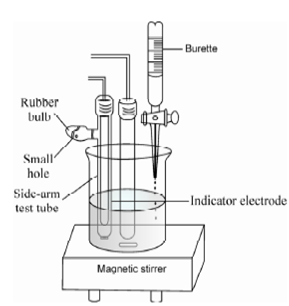Differential Titrations:
This titration needs the use of two identical indicator electrodes, one of that is well-shielded from bulk of solution. Figure given below illustrates a typical arrangement. There one of the electrodes is hold within a small side-arm test-tube. Contact along with the bulk of the solution is made through a small hole in the bottom of the tube. Because of the restricted access, the composition of the solution surrounding the shielded electrode will not be immediately affected by an addition of titrant to the bulk of the solution. The resulting difference in solution composition gives rise to a difference in potential ?E between the electrodes. Previously every potential measurement, the solution is homogenised by squeezing the rubber bulb several times, where upon ?E again becomes zero. If the volume of the solution in the tube that shields the electrode is kept small, an error arising from failure of final addition of reagent to react with this portion of the solution can be shown to be negligibly small. The main advantage of a differential method is the elimination of the need for the reference electrode and salt bridge.

Figure: Apparatus for differential potentiometric titration